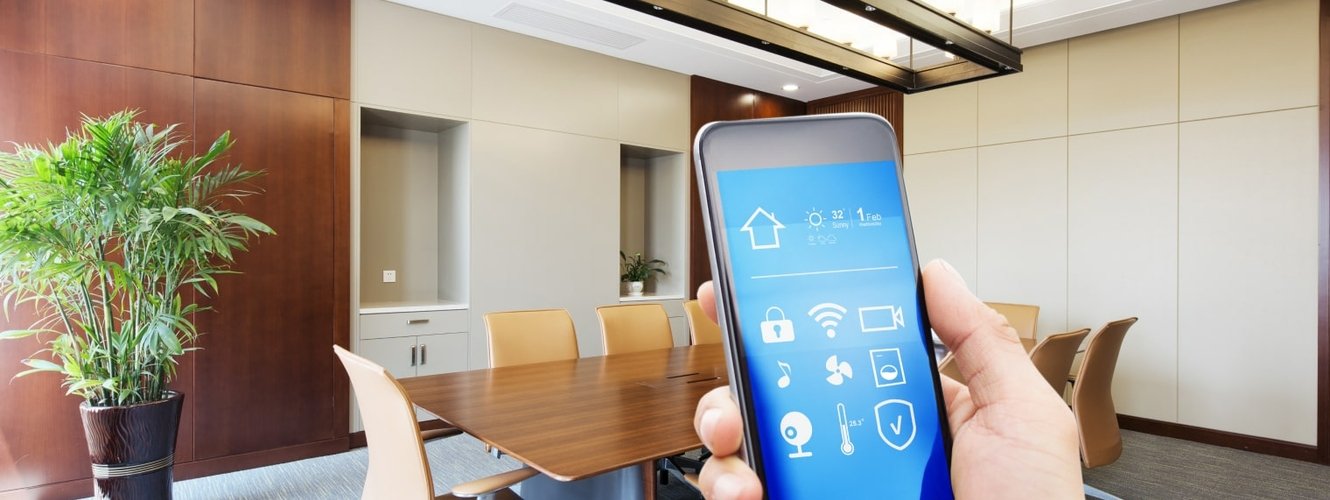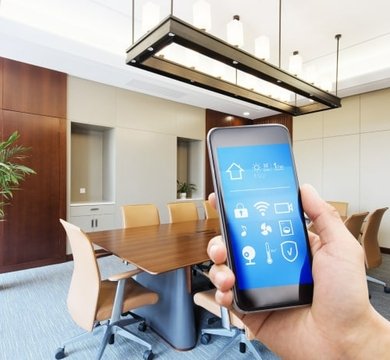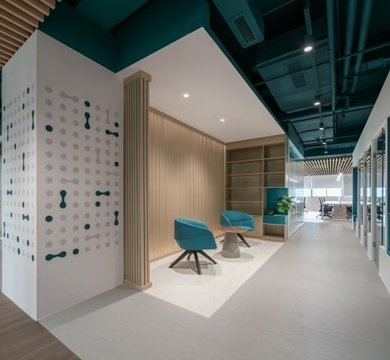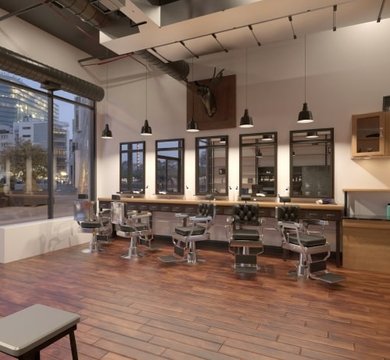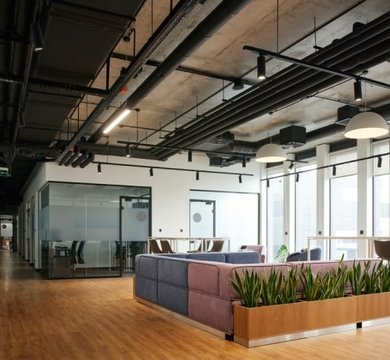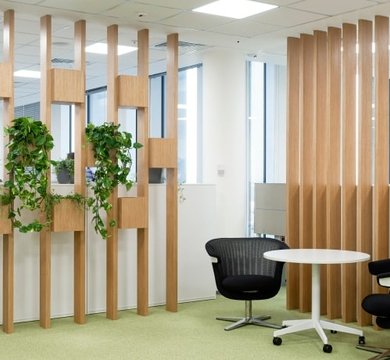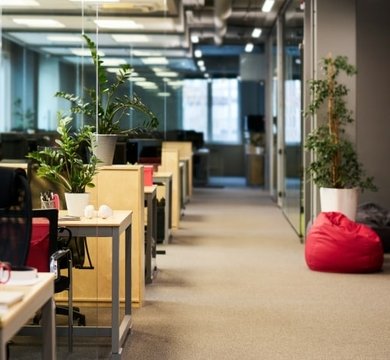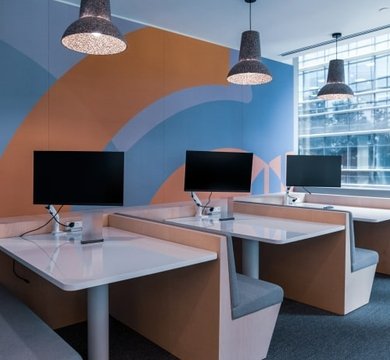Smart office technology uses connected devices, automation and data analytics to streamline operations, improve productivity and enhance the employee experience through integrated systems for lighting, climate control, meeting room booking, security and communication tools.
Smart office technology benefits in the UK include:
- Cost savings and less waste using data-driven decision making
- Increased productivity thanks to enhanced employee satisfaction and comfort
- Simpler, streamlined ways of working that save time and increase efficiency
There is an increasing uptake of intelligent office systems in the UK, with more companies discovering the advantages of smart workplace technology.
A survey by Slack in 2023 found
- 83% of UK workers said having the right technology to collaborate would streamline and accelerate time-consuming/mundane tasks to enable more impactful work
- 25% said AI and automation specifically improved their engagement at work
The CBRE’s 2024 report Transforming Properties into Smart Buildings found
- 50.9% of occupiers will pay a premium if smart office technology that adjusts building operations to reduce environmental impact
- 32.1%% of occupiers will pay a premium for features that reduce energy consumption
In 2025, a Freshworks survey found
- UK organisations are set to increase AI investment by more than 25% in 2025. Over half of employees (61%) consider AI a necessary tool
In this complete guide to intelligent workspaces, we will answer the question what is smart office technology, reveal the top smart office technology benefits and explain how to implement smart office technology.
Essential Smart Office Technology Components
1. Smart Lighting & Climate Control - office automation that automatically controls an office’s comfort levels. Sensors, the Internet of Things (IoT) and Artificial Intelligence (AI) will monitor humidity, temperature and lighting based on occupancy and optimum desirability levels, adjusting without manual interference. This can lead to improved comfort, increased efficiency and energy savings.
Case Study: according to CPD, the UK’s Bustler Market saved 8 tonnes of carbon when it moved into one of the East Midlands’ smartest buildings. Additionally, it enjoys an 80% power consumption saving thanks to app-based, customised intelligent lighting.
2. Meeting Room Booking Systems: smart office solutions can revolutionise how meeting rooms are booked. Employees can quickly locate vacant spaces in real time, as well as pre-book spaces using an app. Data captured can also identify under-used rooms for smarter space planning.
Case study: when Flexioffices relocated a UK fintech company to a new Manchester smart office with AI-driven automation and occupancy controls, it cut meeting room underutilisation by 42%.
3. Security & Access Control: smart workplace technology plays a crucial role in creating a secure office, especially for highly sensitive workplaces. Integrated surveillance systems, RFID tags and biometric access control systems, such as fingerprint scanners, iris recognition and facial recognition, allow safer access to premises and digital files than passwords and fobs.
4. Occupancy & Space Sensors: with hybrid and home working here to stay, smart office technology monitors the flow of people and evaluates space/desk/room usage, providing data-driven insights. Occupancy monitoring highlights what desks and rooms are not being used, which can inform layout reconfiguration or even cost-saving downsizing.
5. Communication & Collaboration Tools: decentralised working has thrown communication and collaboration into the spotlight. Connected office systems ensure everyone, no matter where they are and what device they are using, can video conference, instant message, email, project manage and call using VoIP using one singular platform.
6. Workplace Management Platforms: also known as integrated workplace management systems, smart office solutions can streamline almost every aspect of work life. Customised mobile apps make booking meeting rooms, ordering stationery, reporting maintenance issues and tracking repairs as simple as tapping a screen.
Case study: a smart office set up at 22 Bishopsgate in London has seen predictive maintenance reduce maintenance costs by circa £741,815 annually, according to CBRE’s Transforming Properties into Smart Buildings report.
7. IoT Device Integration: smart office technology relies heavily on three things: WiFi, the IoT and connectivity. Once in place, connected devices, such as HVAC units and AI-optimised lighting systems, will monitor automatically, seamlessly make adjustments using pre-programmed triggers and supply an office manager with data-led reports.
8. Air Quality & Wellness Monitoring: today’s intelligent office systems can include environmental sensors that measure air quality, automatically adjusting filtration to improve the environment. Sensors, smartphone apps and wearable tech can also monitor a person’s health and activity levels. The data gathered is automatically analysed, generating alerts and predicting health issues.
Smart Office Technology Benefits
- Productivity Improvements: The Stoddart Review found that “smarter offices”, with better workplace design and smart office technology could improve productivity by 13.5%, amounting to as much as £70 billion added to the UK economy. Additionally, the UK’s Office for National Statistics found technology adopters were associated with 19% higher turnover per worker.
- Cost Reductions: continual automatic adjustment of your office, based on occupancy levels and outside environmental factors, will result in cost saving efficiencies and a more ESG compliant workplace. In fact, Flexioffices found smart office technology can reduce operational energy use by 22% through occupancy-based control. When powered by AI and IoT systems, companies can cut total energy consumption by up to 33.8% and reduce carbon emissions by 40.7%.
- Employee Experience: there is a direct correlation between productivity, workplace wellbeing and employee comfort. For example, a study by Savills and the British Council for Offices found 72% of participants who were ‘very satisfied’ with the temperature of their office also said their office had a positive impact on their mental health. Additionally, a survey by Freshworks found 72% of UK workers felt positively about the impact AI has had on their workload.
- Operational Efficiency: in 2024, Workday found large UK businesses could save up to 7.9 billion employee hours through the use of AI. Individual business leaders could save 1,117 hours per year if AI was used to its full potential, while individual employees could save 737 hours each year - the equivalent of 92 working days.
Implementing Smart Office Technology: Step-by-Step Guide
If you have a UK office and are wondering how to implement smart office technology, these 6 steps will guide you towards better office automation.
1. Technology Assessment: your first step will be to identify gaps in technology and align this with the current/future needs of your workforce. Critical steps in this phase will include an occupancy audit, analysis of productivity levels, a survey of employees’ needs/wellbeing and an evaluation of current tech systems.
2. Strategy & Budget Planning: the right approach will ensure you save enough money in the future to justify the investment in new smart office technology. Some thorough ROI modelling will determine whether you should take a phased approach, although this should be balanced with the forecast impact on productivity and efficiency.
3. Supplier Selection: as an emerging workplace trend, smart office technology requires a competent, experienced installer. When choosing a UK supplier, you’ll need to ensure its modern office design services offer the highest level of infrastructure and integration capabilities, as well as a proven track record. Choose badly and you’ll risk an expensive suite of equipment that fails to talk to each other.
4. Installation & Setup: although you won’t be knocking down walls or ripping up floors, infrastructure planning and commercial technology fit out will require a degree of office replanning. A methodical approach managed by your UK supplier will ensure minimal disruption but be sure to factor in networking, software installation, testing and configuration.
5. Staff Training: not everyone likes change and some employees will be daunted by new software and office technology upgrades. Factor in enough time and resources to train staff, ensuring they don’t feel rushed or overwhelmed. They will only be enthusiastic adopters if they feel confident with navigating new apps and online platforms.
6. Monitoring & Optimisation: the beauty of intelligent office systems is the automatic delivery of data-driven reports and insights. Learning how to interpret the results and taking action is the only way you can confidently deliver a return on investment – ignoring the data is not an option. The feedback will highlight where efficiencies and improvements can be made.
Smart Office Technology Costs
If your most important question focuses on smart office cost, office automation will depend on where you are in the UK, the size of your office and the level of technology you are prepared to invest in. As well as any new technology, you may need to reconfigure your power and data supplies, as well as cabling, which an office fit-out company can cost for you.
Also remember to factor in any subscriptions and support services into ongoing maintenance costs.
The following costs are estimates, based on the supply and fit of sensors, automated systems and data analytics.
- Basic/low-spec smart office: UK average of £40 - £60 per sqft
- Mid-range/good quality smart office: UK average of £65 - £120 per sqft
- High-end/premium smart office: UK average of £15-+ per sqft
These estimates give you a rough idea but contact us with your specific requirements and we can use a discovery call, together with a site visit, to give you a more accurate figure.
A typical return on investment will depend on the office’s previous efficiency and the breadth/depth of the smart tech installed. You can expect to see a return on invest over an 18 month to 5 year period.
Frequently Asked Questions
Q. What is the ROI of smart office technology?
A. Smart office technology is designed to make workplaces more productive and healthier, while reducing energy consumption and lowering operational costs. Electricity and water bills should be reduced, while staff should have more time to focus on revenue-generating tasks.
Q. How long does smart office implementation take?
A. How quickly you can achieve office automation will depend on the size of your UK office and how many aspects you want to automate. It’s good to know the on-site phase is generally weeks, not months.
Q. What are the most important smart office technologies?
A. Smart office technology that saves money is usually the top priority. Companies should look towards tech that stops utilities being wasted and identifies if offices are underoccupied with a view to downsizing.
Q. Can small businesses afford smart office technology?
A. Smart office solutions don’t have to be installed all at the same time. The current UK technology systems allow businesses to start small and scale up when budgets allow.
Q. How secure is smart office technology?
A. With the right precautions in place, smart office technology poses little to no security threat. There should be a focus on encryption, access controls and periodic security audits, together with employee awareness of data security best practice and compliance with relevant regulations.
Q. What maintenance do smart office systems require?
A. With data being exchanged all the time, smart office systems require regular data back-ups and adequate data storage systems. Software will need to be updated in line with new iterations and you may find it useful to have an open dialogue with a smart technology partner.

